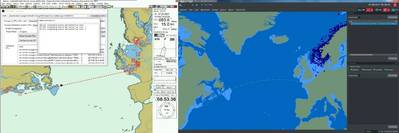Inspired by the European program for Air Traffic Managemen, the Sea Traffic Management (STM) methodology has been developed by the Swedish Maritime Administration MonaLisa project to define a set of systems and procedures to guide and monitor maritime traffic.
The STM Validation project co-financed by the European Union has made the first operational tests with the shore center manufacturers. The key to the interoperability between different systems is the robust underlying infrastructure. The standardized information exchange mechanism makes it possible for actors to connect seamlessly at the first attempt and without any discussions on formats, interfaces or communications means.
The successful operational test started with the Adveto ECDIS system doing a look-up of the Kongsberg Norcontrol Shore Center services in the service registry. The ship then shared the voyage plan, which was instantly available in the shore center for checking, monitoring, confirmation, new suggestions, etc. The underlying Sea Traffic Management (STM) and Maritime Cloud infrastructure managed a secure and trusted transmission directly between authenticated actors.
According to Kent Sylvén, CEO Adveto, “Connecting the ECDIS with real-time secure services from any STM-compatible service provider on shore can improve the decision-support for bridge officers. I have no doubt that STM also will reduce costs and improve economy for all involved parties. Furthermore I believe that STM also can reduce accident rates.”
Lene Vesterlund, VP marketing and sales at Kongsberg Norcontrol, said, “For Kongsberg Norcontrol, STM is a chance to expand our business by delivering services that will increase the efficiency and safety of the maritime transport system worldwide. We can connect machine-to-machine, through standardized interfaces, with on-board systems from all manufacturers.”
The shore centers in the STM Validation test bed will support ships with services that will increase the safety for the ship and its surroundings and improve the efficiency of the transport system. Studies indicate more than 60 percent reduction of human related accidents and €100 millions of savings.
The STM test beds will include 300 ships, 13 ports and at least five shore centers.














